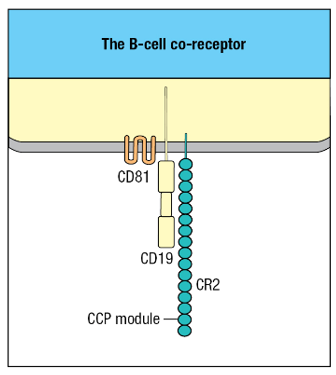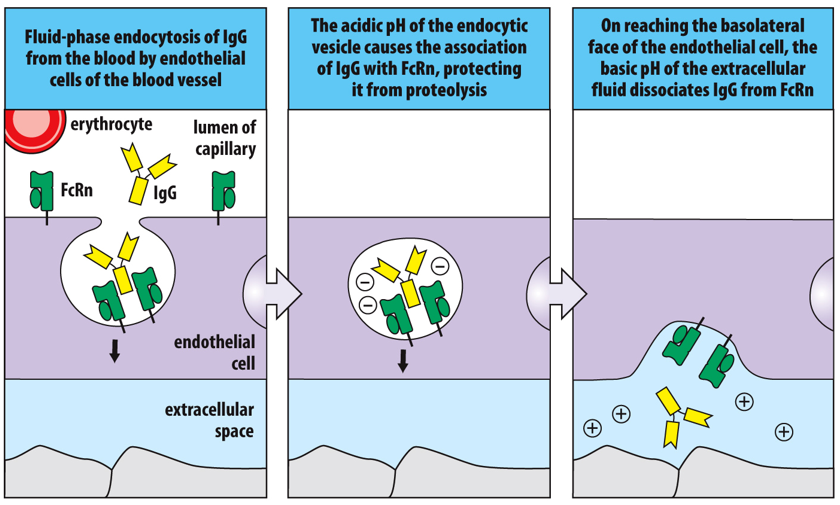Chapter 9: Immunity Mediated by B Cells and Antibodies
1/35
There's no tags or description
Looks like no tags are added yet.
Name | Mastery | Learn | Test | Matching | Spaced |
|---|
No study sessions yet.
36 Terms
B-cell activation requires cross-linking of the _____________ (two or more receptors)
B-cell receptor
Receptor associated _____________ phosphorylate tyrosine residues in the ITAMs of cytoplasmic tails of Igα (blue) and Igβ (orange). Syk binds to the phosphorlated ITAMs of the B-cell receptor Igβ chains.
tyrosine kinases

The B cell co-receptor is composed of _____, _____, and _____.
CR2; CD19; CD81

Phosphorylated ____ generates _____________that synergize with those generated by the B-cell receptor.
CD19; intracellular signals
TFH cells help antigen-activated B cells through cell-surface interactions between ________________________ and by the targeted delivery of secreted cytokines to the B-cell surface.
CD40 ligand (TFH cell and CD40 (B cell)
(MTOC) Microtubule-organizing center
Cellular structure responsible for the nucleation, stabilization, and organization of microtubules
Replication of B cells happens in the ________________. B cells start to produce ____ here as well.
medullary cord; IgM
B cells interact with TFH cells in the _____________- where the TFH cells release _________ for further B cell maturation.
boundary zone; cytokines
Expansion of antigen-activated B cells in the primary folicule creates the ___________________. This is where _________ and ________ occurs.
germinal center; affinity maturation; class switching
Class switching of B cells is based on ___________ release and interaction.
cytokine
A _____________ is a small, non-dividing B lymphocyte that is found in the germinal centers of secondary follicles.
centrocyte
TFH cell cytokines _____ and _____ promote differentiation of antigen activated B cells into plasma cells (produces antibodies) or memory cells
IL-21; IL10
As infection subsides, _____________________ under the influence of the same cytokines into long-lived memory B cells
centrocytes differentiate
____, _______ and monomeric _____ protect the internal tissues of the body
IgM; IgG, IgA
The receptor ___ transports ____ from the bloodstream into the extracellular spaces of the tissues
FcRn; IgG

IgM, IgG, and IgA bind and _________ any _____________ that enter the blood and tissues
neutralize; microorganisms
__________ IgA, and ___________ IgM protect __________________ of the body
Dimeric; pentameric; mucosal surfaces
Transcytosis
Transport of molecules from one side of the epithelium to the other. This involves endocytosis into vesicles
A _________ is made between one _______________________ of either one IgA dimer or one IgM pentamer
disulfide bond; poly-Ig receptor and the J chain
The receptor is called polymeric immunoglobulin receptor (or ____________) because _________________________
poly-Ig receptor; it specifically binds to IgA dimers or IgM pentamers
______ provides a mechanism for rapid killing of ________ and __________.
Functions as a cell-surface receptor of antigen not as a soluble antibody
IgE; parasites; pathogens
____________ contain large granules containing _______________________________________
Mast cells; histamine and inflammatory mediators
________________ that is present on the surface of____________________________________
Fc receptor called FcεRI; mast cells, basophils, and activated eosinophils
Two or more IgE/FcεRI ______________ causes _____________. Can also cause __________
crosslinked; degranulation; allergy
Before and after birth, mothers provide their children with protective _____________
antibodies
During pregnancy ___ from the maternal circulation is transported across the __________________ and delivered directly to the ______________
IgG; placenta by FcRn; fetal bloodstream
Transfer of IgG across placenta into fetal bloodstream by FcRn is so efficient that, at birth, human babies have a level of IgG in their plasma that is as ________________, and with as ______________ of antigen specificities.
high as that of their mothers; wide a range
The transfer of _________________________________________ is an example of the passive transfer of immunity
preformed IgA from mother to child in breast milk
Protein-F binds ___________
fibronectin
Disease-causing bacterial infections at mucosal surfaces are prevented by neutralizing antibodies. The antibodies________________ and _______________________ to bind to the cilia or to attach to the fibronectin in the extracellular matrix, and so they prevent the bacteria from remaining in the pharynx.
coat the bacteria; impair the capacity of protein F of the bacteria
Binding of IgM and IgG (multiple) to antigen on a pathogen’s surface activates complement by the ____________
classical pathway
Membrane attack complex (MAC)
C5-C9 (polymerization of 18 C9 molecules
At least ______________ of IgG bound to pathogens or soluble antigens are required to activate the complement cascade.
two molecules
___________________ helps to clear immune complexes from the circulation.
Erythrocyte CR1
___________________________ can be bound by cells expressing the complement receptor CR1. Most numerous of the cells expressing CR1 is the erythrocyte, or ___________, which outnumbers the leukocytes by about 500 to 1. Thus, most immune complexes become bound to the surface of erythrocytes.
Immune complexes covered with C3b; red blood cell
Erythrocytes _________________________ where tissue macrophages remove and degrade the complexes of ______________________ from the erythrocyte surface.
pass through the liver and spleen; complement, antibody, and antigen